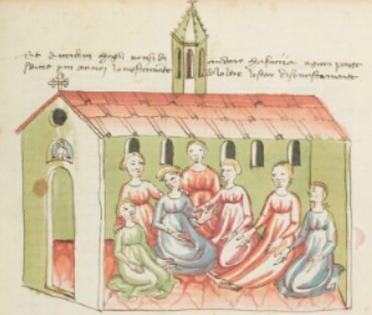Back to the beginning?
The open end of the "Decameron"
By literary scholar Pia Claudia Doering (Romance studies)

As demonstrated by the examples in Martina Wagner-Egelhaaf’s dossier article “End without end? How literature depicts the end of epidemics”, how epidemics end does not seem to be a particularly central concern for literature. Boccaccio’s Decameron supports this finding: the collection of short stories begins with a detailed and dramatic description of the plague and the collapse of Florence’s urban order resulting from it. The community of narrators, consisting of seven young women and three young men, come together in the church of Santa Maria Novella, and decide to leave the city and seek shelter on their estates in the contado. To pass the time, they choose to tell short stories, which they structure in a particular way: on each of the ten storytelling days, ten stories are told, and each member of the closed society is queen or king for one day and has the privilege of prescribing a daily theme. This rigid structure, which only Dioneo, the enfant terrible of the group, is excepted from, acts as an antithesis to the chaos in Florence.
After the telling of the 100th story, the young people return to Florence and to the exact place where they began their undertaking: the church of Santa Maria Novella:
E come il nuovo girono apparve, levati, avendo già il siniscalco via ogni lor cosa mandata, dietro alla guida del discreto re verso Firenze si ritornarono; e i tre giovani, lasciate le sette donne in Santa Maria Novella, donde con loro partiti s’erano, da esse accommiatatosi, a’ loro altri piaceri attesero, e esse, quando tempo lor parve, se ne tornarono alle lor case.
Next morning they arose at the crack of dawn, by which time all their baggage had been sent on ahead by the steward, and with their wise king leading the way they returned to Florence. Having taken their leave of the seven young ladies in Santa Maria Novella, whence they had all set out together, the three young men went off in search of other diversions; and in due course the ladies returned to their homes. (Giovanni Boccaccio, the Decameron. Translated by GH McWilliam, London: Penguin, 1972, 797)
The ending quoted here marks a return to the beginning. Externally, nothing has changed, since the situation in Florence has not changed for the better in the space of a fortnight; there is no end in sight to the epidemic. So why do the young people return? And why, unlike their flight from Florence, which they justified by referring to the duty of natural law to preserve their own lives, is their return to the still plague-ridden Florence not problematized at all?
One possible answer lies in Boccaccio’s evaluation of narrative, which is presented in the Decameron as a remedium in times of crisis (see my dossier article “Boccaccio’s Decameron or the art of narrative as a remedy against the plague”). Vittore Branca, the great Boccaccio expert and editor, has described the narrative process in the Decameron as “un vero itinerario catartico”. The act of narration not only purifies the young people of harmful passions in the Aristotelian sense of catharsis, however. The stories also subject the socio-political, religious, legal, and economic conditions in Florence and other Italian cities to critical scrutiny. Thus, although the narrators do not now have a medical cure for the plague, they are nonetheless stronger in their inner attitudes and more sensitize to social ills that endangered the urban order even before the outbreak of the plague.

